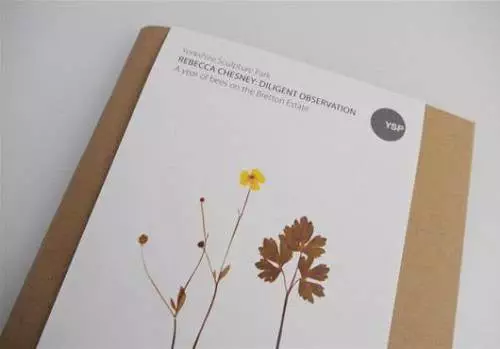Guest blog post by Tamsin Constable
It was always going to be a challenge trying to talk to artist Rebecca Chesney about her exhibition Diligent Observation with two children in tow. But I was determined to do so. After all, her work is all about bees. And anyone who can capture the beauty and magic and symbolism and loveliness and folklore of bees is, in my book, worth at least an ice-cream bribe. So I gave my nine-year-old the video camera and told him to try to keep it steady and not sniff too loudly.
I’d already had a good old nosey around Rebecca’s blog to get a feel for her personal insights during her year-long project looking at bees on the YSP’s Bretton Estate. It’s a lovely piece of work in its own right. The first time she found a bumblebee she wrote: “It was a beautiful, big, fat hairy thing. It was huge. I could see it for ages as it flew off – I feared for unattended children being swooped upon and whisked off by it.”
Much of Rebecca’s previous work has been about landscape, how we perceive nature and our effects on our environment. But it wasn’t until she started looking native bees that she realised just what an enormous task it was going to be – there are hundreds of species. There are pictures that represent the sounds she recorded from the honey beehives, and the layers of buzzes seem to rev clean out of the frames and into the otherwise rather silent exhibition.
For honeybees, Rebecca went on a bee-keeping course and set up some hives. There is a delightful row of notebook pages of painted rectangles – the stripe system to identify bumblebees. As for solitary bees – well, there are some 200 species in the UK, and one set of pictures charts Rebecca’s attempts to grasp the impossibly complicated key system used to classify solitary bees. And I will never, ever, sweep a dead bee off a windowsill again after Rebecca’s fabulous collection of dead honey bees and bumble bees, some still loaded with pollen, industrious even in death.
I was surprised at the paucity of bees around the Yorkshire Sculpture Park. I hadn’t really given it much thought, but had assumed that such a large estate would naturally be doing OK in terms of bees. But I was sad to learn how wrong I was. It’s not about space, of course, but about management. Rebecca’s attempts to establish bee-friendly meadows at the YSP never progressed beyond a couple of small trial sites.
Bees are declining. Anything that any of us can do to help them can only be a good thing, whether it’s lavender in the garden or an acre or two of meadow at the Yorkshire Sculpture Park. I’d bring my family here more often, if there were more bees to see and some honey to buy. And wouldn’t it be great if, long after her exhibition has been packed up and stored, Rebecca Chesney’s hard work left some kind of permanent biodiversity legacy at the YSP?
Tamsin also blogs at Tamsin Constable and Looking for Dragons
